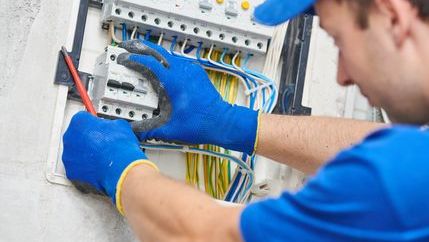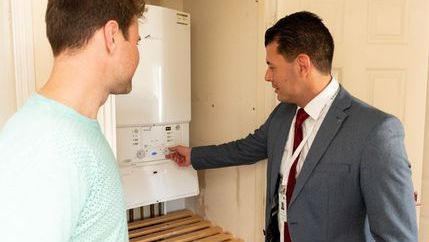Smoke alarms and carbon monoxide (CO) alarms
It is a legal requirement for all rental properties in England to adhere to the Smoke and Carbon Monoxide Alarm (Amendment) Regulations 2022. All landlords should fully understand these regulations and you (or your agent) should ensure alarms are in place. Any landlord found to be in breach could be fined up to £5,000.
Since 2015, it has been a legal requirement for at least one smoke alarm to be installed on each storey of the property where a room is used as living accommodation.
Carbon monoxide alarms must be installed and in proper working order in any room used as living accommodation which contains a fixed combustion appliance (excluding gas cookers). These appliances are generally powered by gas, oil, coal or wood, like gas or oil-burning boilers or a wood-burning stove. There should also be at least one smoke alarm on every floor of the property where a room is used or partly used as living accommodation.
Every alarm must be in proper working order on the first day of a new tenancy. Any alarms must be repaired or replaced once you have been informed that they have been found faulty.
All private rented homes in Wales need to be fit for human habitation. This requires a smoke alarm to be fitted on every storey of a property and to be in proper working order. The alarms must be connected to the electrical supply.
The fit for human habitation regulations require landlords to ensure a carbon monoxide alarm is present in any room which has a gas, oil, or solid fuel burning appliance installed.
As the landlord, you (or your agent) should make sure that any solid fuel and oil heating installations are safe.
You should also carry out routine maintenance, including the sweeping of chimneys and flues. View the full guidance for landlords in Wales here.
Since February 2022, every home in Scotland must have interlinked fire alarms that all go off if one activates. Since 2019, the Scottish Government has provided further clarification on the location of alarms, which specifies that each home must have:
- One smoke alarm in the room that is used the most
- One smoke alarm in every circulation space on each storey, such as hallways and landings
- One heat alarm in every kitchen
- All alarms should be interlinked
- All alarms should be ceiling mounted
If a home has a room with a carbon-fuelled appliance, such as a boiler, fire, heater or flue, then that room must also have a carbon monoxide detector. This does not need to be linked to the fire alarms.
View Scottish Government fire safety guidance here and guidance specific to carbon monoxide here.
Additional guidance can be found here: Fire and smoke alarms: changes to the law - gov.scot (www.gov.scot)
The Smoke, Heat and Carbon Monoxide Alarms Regulations (Northern Ireland) 2024 set the standards for the number and type of alarms that landlords must install in their properties. The rules apply to new tenancies from 1 September 2024 and all other private tenancies from 1 December 2024.
As a landlord, you must ensure that each of your privately rented properties has a minimum of one:
- heat alarm in every kitchen
- smoke alarm in the main living area (usually the living room or lounge) and circulation space
- carbon monoxide alarm in each room or circulation space that has a gas appliance other than a gas cooker (e.g. a gas fire or a boiler). This includes any bedrooms that a flue passes through.
- If multiple carbon monoxide alarms are installed, it is recommended that they must be interlinked but that is not a legal requirement.
If a smoke alarm is more than 7.5 metres from any point in the room, then you must install another alarm. The only exception is if the room contains a kitchen. In that case, the second alarm should be a heat alarm.
All smoke and heat alarms must be interlinked, with all alarms either hard wired, battery sealed or a combination of both. If alarms are battery sealed, they should be tamper-proof with long life batteries. All alarms must be installed on the ceiling, with the exception of carbon monoxide alarms which can also be wall mounted.
At the start of any tenancy, you (or your letting agent) must confirm that the tenant is satisfied that all alarms are in working order. You need to keep a record of when alarms are installed or replaced, and a copy of this should be given to your tenant. Once the tenancy commences, tenants must be advised to test the alarms regularly, based on any specific instructions from the alarm’s manufacturer.
You must advise your tenants to test the alarms once per week and report any faults as soon as possible. Once a fault is reported, or when an alarm is due to be replaced, you (or your letting agent) must take remedial action. Alarms must be replaced before or on their expiry date, not after. You will be liable for an offence if you fail to replace faulty alarms or any alarms before the expiry date
For more information, you can read the guidance notes at the Department for Communities website.
Electrical safety obligations
In England, Wales and Scotland, you have a legal duty to ensure that any electrical items you have provided in your rental property are safe throughout a tenancy. As well as all appliances, you must also ensure all electrical systems such as sockets, switches and light fittings are safe.
Electrical safety standards
The electrical safety standards for the private rented sector in England came into force on 1 June 2020 and applies to all new tenancies from 1 July 2020 and all existing tenancies from 1 April 2021. The regulation sets out new rules for landlords to ensure all fixed electrical installations are safe and maintained correctly.
Electrical safety for landlords in Scotland
It is a legal requirement for landlords to carry out electrical safety inspections for all new and existing tenancies. There are two parts that you are required to complete:
- inspection of installations, fixtures and fittings
- a record of testing of appliances
Tests must be carried out at least every five years by a competent person. After an inspection, you must provide a copy of the inspection document to your Tenants. When a new tenancy starts you must give a copy of the most recent inspection to the tenants. For electrical safety advice, see electricalsafetyfirst.org.uk
Electrical safety for landlords in WALES
The Renting Homes (Wales) Act requires all rented properties to have periodic inspection and testing (PIT) of all electrical installations. Tests must be carried out at least every five years, producing an Electrical Installation Condition Report (EICR).
The current EICR must be made available to the tenant within seven days of their occupation date. Failure to comply with any of the regulations could result in prosecution. View the full guidance for landlords in Wales.
Gas safety checks for landlords
Research has shown that more than one in three private landlords did not know it was their responsibility to get gas appliances checked. With this in mind, are you aware of your legal requirements concerning gas safety?
Legionella
Legionnaires’ disease is a pneumonia-like infection commonly caused by inhaling small droplets of water contaminated with Legionella bacteria. Landlords must assess and control the risk of tenant's exposure to Legionella. Control measures include:
- Flushing out the water system before letting the property
- Ensuring cold water tanks have a tight lid to stop debris from getting into the system
- Setting control parameters to ensure water is stored at the correct temperature
- Removing unused pipework
You should inform your tenants about control measures they can take. These could include cleaning showerheads or running all the taps for five minutes if they've been away. Tell them to let you (or your agent) know if problems occur with the water system, or if the water's not heating properly.
You should keep records of any legionella assessments and plan follow up checks to be carried out periodically. For more advice on controlling the risk of Legionella, visit the Health and Safety Executive.
Furniture and Furnishings
The Furniture and Furnishings (Fire) (Safety) Regulations 1988 set levels of fire resistance for domestic upholstered furniture, furnishings and other products containing upholstery. All furnishings should pass the 'smouldering cigarette' and 'match flame' resistance test and carry a label confirming this.
Generally, items manufactured in the UK after 1990 meet the required standards and display the appropriate permanent label confirming compliance. If items do not comply, they should be removed from the property before it's let unless they are deemed an exemption, e.g. furniture manufactured before 1950.
Need extra support? Find your local Propertymark Protected expert

Propertymark members can take care of everything for you. They offer different levels of service so you can choose what's best for the time you have. By using a Propertymark member you are guaranteed to be consulting with a professional agent who will give you up-to-date advice and guidance on the rental market.





